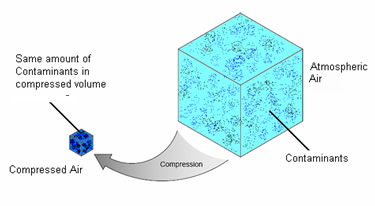- +91 93769 76713
- sales@exalcorp.com
Air that is compressed to pressures greater than that of the atmospheric pressure of 1 Bar. Compressed air, also know as an industry’s fourth utility is used in almost every industry today. The standard pressure at which compressed air applications are typically used is 100 psig or 7 Bar. This pressure enables the air to be used as a motive force instead of electricity in a wide variety of application making the utility safer and more convenient.
Compressor takes in air from the atmosphere and compresses the atmospheric air to the desired pressure. A wide range of compressors are used in industries today. Examples of compressor types include: Centrifugal, Reciprocating, Screw etc.
Compressed air from a compressor is always ridden with moisture and dirt. Such contaminants adversely affect the performance of the application in which compressed air is used. Contaminants in compressed air include moisture, oil and dirt. The bad effects of contaminants can be seen in many forms:
Moisture damage is one of the most serious problems facing the compressed air industry. Problems caused by moisture alone include:
Compressed air from a compressor is always ridden with moisture and dirt. Such contaminants Commercial effects of contaminants can be translated as:

© 2022 Exalcorp • All Rights Reserved